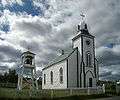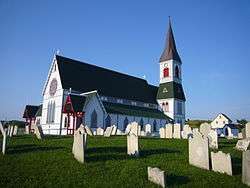Trinity, Newfoundland and Labrador
| Trinity | |
|---|---|
| Town | |
|
St. Paul's Anglican Church in Trinity | |
 Trinity Trinity in Newfoundland and Labrador | |
| Coordinates: 48°22′32″N 53°23′41″W / 48.37556°N 53.39472°W | |
| Country |
|
| Province |
|
| Settled | 18th century |
| Area | |
| • Total | 12.92 km2 (4.99 sq mi) |
| Population (2016) | |
| • Total | 169 |
| • Density | 13.1/km2 (34/sq mi) |
| Time zone | Newfoundland Time (UTC-3:30) |
| • Summer (DST) | Newfoundland Daylight (UTC-2:30) |
| Area code(s) | 709 |
Trinity is a small town located on Trinity Bay in Newfoundland and Labrador. The town contains a number of buildings recognized as Registered Heritage Structures by the province.
History
The harbour at Trinity was first used by fishing ships around the 16th century. The Portuguese explorer Gaspar Corte-Real named the location "Trinity" as he arrived on Trinity Sunday, 1501[1] although another account gives his arrival as 1500.[2]
Fishermen from the West Country of England began using Trinity as a summer station in the migratory fishery in the 1570s. Summer fishermen continued to be primarily from the Channel Islands, especially Jersey, and Weymouth in Dorset until a permanent settlement was established. Trinity was settled by merchants from Poole, England during the 18th century, citing reasons such as the easily defensible harbor and abundance of shore space for fishing premises.[3] Trinity was the site that Sir Richard Whitbourne held the first court of Admiralty in 1615,[4] establishing the first court of justice in North America.[5]
The merchant trade in Trinity was significant and dominated the social and economic life from Baie Verte to White Bay (Newfoundland and Labrador). At times, merchants in Trinity exported upwards of 30-40% of cod, train oil, and seals produced in Newfoundland. By the late 18th Century, the merchant firms in Trinity were operatoring 35 ocean-going ships, exporting 100,000 quintals of dried cod and supplying about 6,000 inhabitants.[6]
A fort was established at Admiral's Point near Trinity in order to protect the assets of the merchants. Due to Trinity's prominence in the British-Newfoundland trade, it was attacked and twice captured by the French in the Anglo-French Wars of 1696-1713, first in 1696 and again in 1705. Both times, the properties of the residents were burnt. Trinity was again captured by the French during the Seven Years' War by Admiral de Ternay.[7]
Trinity was the site of medical research, including the introduction of the smallpox vaccine to the new world in 1798 by John Clinch, a boyhood friend and medical colleague of Edward Jenner.[8][9]
Religious activities in Trinity date back to the early years. The first parochial church was built in 1729 and Rev. Robert Kilpatrick, the first missionary of the Society for Propagation of the Gospel, arrived. During a tumultuous time in Trinity's history, a visiting Methodist preacher, John Hoskins, was tarred by sailors in 1780 - a resident Methodist preacher did not arrive until 1816. Construction on a new parish church began in 1820 and housed the Rev. Aubrey Spencer who later became the first Church of England bishop of the diocese of Newfoundland and Bermuda. In 1827, St. Paul's Church in Trinity was consecrated by Bishop Inglis of Nova Scotia. For this occasion, the hymn "We Love the Place, O Lord" was composed by Rev. William Bullock and has since gained widespread use.[10]
The decline of Trinity began in the mid-19th century as major firms reduced their direct overseas trade and began to rely on commercial links with St. John's. The Ryan brothers of King's Cove and Bonavista continued their retail and general supply trade on the Lester-Garland Plantation until 1947.[11]
The Trinity Record, a weekly newspaper, was in print in Trinity from 1886 to 1900.[12][13]
Trinity was incorporated as a town in 1969.[14]
According to the 2006 Statistics Canada Census, the population of Trinity declined 20.4% from 2001-2006 and had 146 dwellings.
Popular culture
Trinity was used as a filming location for the 2001 film The Shipping News and for the 2002 television miniseries Random Passage.
Trinity is the birthplace of Bob Fowler, an olympic runner who competed at the 1904 and 1906 olympic games. In 1909, Fowler set the world record for fastest time in a marathon, finishing in 2:52:45.4 at a race in Yonkers, New York.
 Church of the Most Holy Trinity
Church of the Most Holy Trinity Parish Hall
Parish Hall.jpg) Courthouse, Gaol, General Building
Courthouse, Gaol, General Building.jpg) Lester-Garland Premises and the Rising Tide Theatre
Lester-Garland Premises and the Rising Tide Theatre
See also
References
- ↑ http://www.the-discovery-trail.com/
- ↑ Rowe, Frederick (1980). A History of Newfoundland and Labrador. Canada: McGraw-Hill Ryerson Limited. p. 12. ISBN 0-07-092397-3.
- ↑ Handcock, Gordon (1996). The Story of Trinity. Trinity: The Trinity Historical Society. p. 1. ISBN 098100170-X.
- ↑ Rowe, Frederick (1980). A History of Newfoundland and Labrador. Canada: McGraw-Hill Ryerson Limited. p. 12. ISBN 0-07-092397-3.
- ↑ "Newfoundland and Labrador". Nations Encyclopedia. Retrieved May 27, 2014.
- ↑ Handcock, Gordon. The Story of Trinity. Trinity: The Trinity Historical Society. p. 2. ISBN 098100170-X.
- ↑ Handcock, Gordon. The Story of Trinity. Trinity: The Trinity Historical Society. p. 2. ISBN 098100170-X.
- ↑ Piercey, Terry (August 2002). "Plaque In Memory Of Rev. John Clinch". Retrieved 28 May 2014.
- ↑ Handcock, Gordon (1996). The Story of Trinity. Trinity: The Trinity Historical Society. p. 1. ISBN 098100170-X.
- ↑ Handcock, Gordon. The Story of Trinity. Trinity: The Trinity Historical Society. pp. 61–63. ISBN 098100170-X.
- ↑ Handcock, Gordon. The Story of Trinity. Trinity: The Trinity Historical Society. p. 3. ISBN 098100170-X.
- ↑ Rowe, Frederick (1980). A History of Newfoundland and Labrador. Canada: McGraw-Hill Ryerson Limited. p. 307. ISBN 0-07-092397-3.
- ↑ Handcock, Gordon. The Story of Trinity. Trinity: The Trinity Historical Society. p. 64. ISBN 098100170-X.
- ↑ Handcock, Gordon. The Story of Trinity. Trinity: The Trinity Historical Society. p. 64. ISBN 098100170-X.
External links
- Text and Music of the Hymn "We Love the Place, O Lord", Written in Trinity
- Heritage Tour of Trinity
- Restoration of the Lester-Garland House
Coordinates: 48°22′32″N 53°23′41″W / 48.37556°N 53.39472°W
